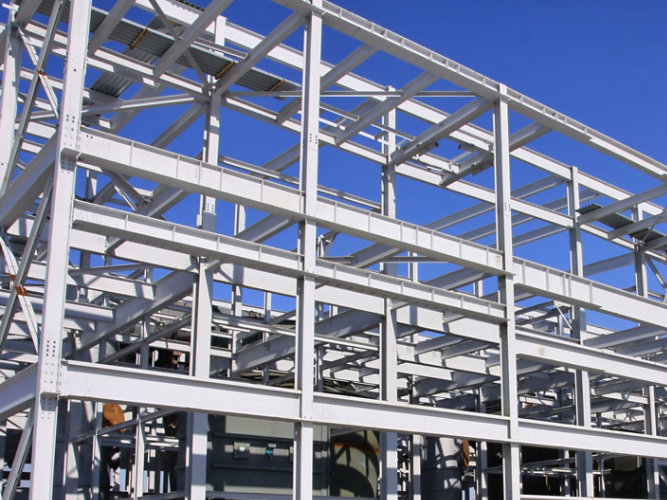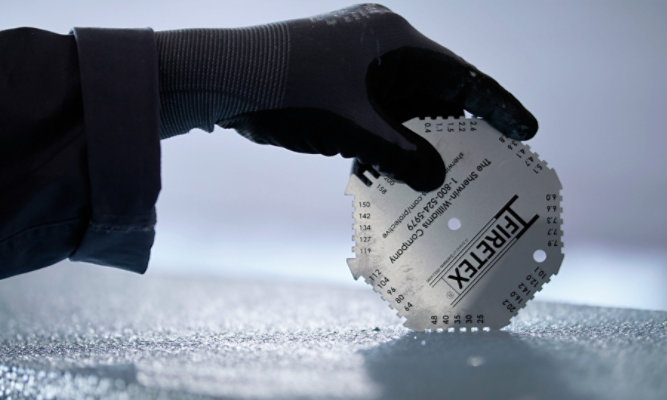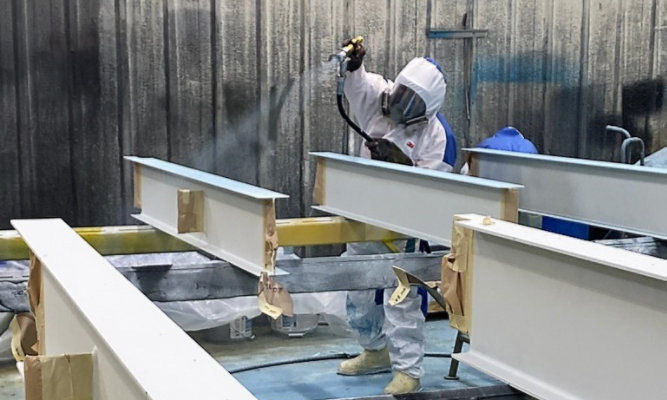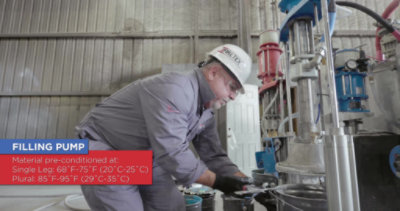Why You Should Never Extrapolate Intumescent Fireproofing Coating Thicknesses with Structural Steel
Understanding the Risks and Dangers of Extrapolating Intumescent Fireproofing Thickness
by George Guanci, Market Manager – Fire Protection, Sherwin-Williams Protective & Marine
Contact Us for More Information

Examining Intumescent Fireproofing Coating Thickness Specifications
Structural steel fireproofing for buildings is a critical life safety and liability consideration.
All the decisions anyone makes along the fireproofing specification chain – whether they come from a coating manufacturer, applicator, building designer or code official – must be based on that fact. That means all parties should respect the rules of regulations and follow a common standard – to a “T” – so everyone is speaking the same specification language.
Unfortunately, some key stakeholders may mistakenly view published intumescent fireproofing coating thickness specifications as guidelines that can be adapted to a particular situation. For example, the ANSI/UL 263 (ASTM E119) “Fire Tests of Building Construction and Materials” specification for fireproofing lists the recommended intumescent coating thicknesses for a wide array of steel member profiles, but not every possible profile that could be used in a building. Those verified thicknesses are based on tests that UL Solutions performed on specific pieces of steel.
Where some stakeholders run into trouble is when their building design includes steel profiles that are not listed in ANSI/UL 263 (ASTM E119). In such cases, specifiers may think it’s OK to extrapolate the proper coating thickness for a steel member, assuming that splitting the difference between tested, similarly sized pieces would be fine. That practice is permitted by UL Solutions when using cementitious or spray-applied fire resistive materials. However, it is not permitted for intumescent coatings – and for good reason (Figure 1).
An extrapolated intumescent coating thickness may be too low or too high, presenting a life safety concern in either case. If the coating thickness is too low, the intumescent materials won’t deliver the specified fire protection. Or, if it is too high, a complete loss of fire protection is possible, as the weight of the material’s insulative char could cause the intumescent coating for steel to delaminate from the substrate (Figure 2).
With fireproofing being all about life safety and liability, any variance from established, tested standards is too risky and therefore not acceptable. This article will explain why that’s true and how to avoid extrapolating intumescent fire-resistive coating thicknesses.
Setting the Standard for Intumescent Fireproofing Thickness with UL Solutions
UL Solutions (previously known as Underwriters Laboratories or UL) is an obvious standard bearer for fireproofing coating specifications. It is one of the most internationally recognized approval bodies for fire-resistance performance. That’s why fireproofing specifications, particularly in North America, follow ANSI/UL 263 (ASTM E119) guidelines.
UL Solutions thoroughly investigates construction material properties and provides guidelines that instruct the industry on how to properly use its testing results. Those guidelines include published intumescent coating thicknesses for specific steel member profiles. The guidelines are based on a variety of factors, including the steel member’s overall dimensions and thickness, where and how it is used in the structure, the structure’s required fire protection duration and more.
UL Solutions conducts initial fire-resistance performance testing, as well as follow-up quality auditing services to ensure manufactured products remain consistent. As such, the UL Solutions listing system is recognized throughout the world as covering reliably manufactured, tested and evaluated products.
Anyone involved with specifying or using a fireproofing/fire-resistive product listed by UL must ensure that its ultimate end use is carried out in accordance with the relevant UL listing and UL Design Guides (Figure 3). These can all be accessed in the UL Solutions Fire Resistance Directory and on the organization’s website.
Excluding Extrapolation for Intumescent Fireproofing Thickness
Surprisingly, given the life safety nature of fireproofing and the specific requirements stated by UL in its Fire Resistance Directory, UL Solutions’ listings can still be prone to inconsistent interpretations.
The most relevant design guide for fireproofing is the BXUV guide for UL 263-compliant fire-resistance ratings.
As established above, some fireproofing manufacturers may follow the practice of extrapolating or “extending” fireproofing thickness requirements for intumescent fire-resistive materials beyond the range listed and tested in individual UL design listings. This practice not only violates UL Solutions’ requirements, but also disregards the life safety and liability nature of fireproofing.
Granted, there may be some explanation for misunderstanding the BXUV design guide, as extrapolations are permitted for cementitious or spray-applied fire-resistive materials. In fact, the guide includes a formula for calculating thickness requirements for such materials.
Figure 1. The practice of extrapolating the proper intumescent fire-resistive coating thickness for an unlisted steel member profile is not permitted per ANSI/UL 263 (ASTM E119) guidelines.
Figure 2. Applying the proper thickness of intumescent fire-resistive materials on every steel member profile is critical to ensuring the desired fire protection rating for a structure.
Figure 3. Specifiers and applicators must ensure the end use of intumescent fire-resistive materials is carried out in accordance with the relevant UL listing and UL Design Guides.
When it comes to intumescent fire-resistive materials, however, extrapolated thicknesses are not permitted.
The BXUV specifically states that “the mastic and intumescent coating average thickness should not exceed the maximum thickness published in the individual designs.” It also notes that “extrapolation of member size and/or material thickness shown in the individual designs has not been investigated and would be considered to void the existing certified assembly.” The UL Solutions Best Practices Guide also includes this prohibition.
Consequently, specifiers simply are not permitted to use a UL Solutions design listing to calculate an extrapolated thickness for intumescent fireproofing coatings.
Exposing the Problems of Extrapolation for Intumescent Fireproofing Thickness
Regrettably, despite the UL Solutions policy, extrapolated intumescent coating thicknesses continue to be issued for structural elements for which there is no UL listed or permitted thickness. A manufacturer that issues an extrapolated thickness recommendation may issue a letter noting that it has conducted a mathematical or engineering analysis of a specific named UL design and arrived at an extrapolated thickness. However, this violates UL policy and risks the life safety nature of the intumescent fire-resistive material.
Fireproofing thickness is based on a number of factors, including: the hourly fire protection rating, whether the structural element is a beam or column, the type of steel profile (e.g., a “W-Section” or an “HSS-Section”), the mass of the steel and the surface area exposed to the fire.
In general, the thicker the steel, the thinner the fireproofing, and the thinner the steel, the thicker the fireproofing. But there are limitations, particularly with thicker coating applications.
As intumescent fireproofing coatings react to heat exposure from a fire, they form a thick char that insulates the coated steel from the heat source. With thicker coating applications, the char itself is also thicker and heavier. Danger presents when that char becomes too heavy to remain adhered to the steel substrate. In such cases, the char will likely fall off, removing the protective coating material with it and leaving structural steel exposed directly to heat. That steel may therefore not meet the required hourly rating that the rest of the structural steel does, creating a potential weak point that increases the risk of a catastrophic collapse. This phenomenon can apply to both columns and beams, but it is particularly dangerous with a beam.
Preventing Intumescent Fireproofing Thickness Extrapolations
What can be done to prevent the use of extrapolated thicknesses? Here are several recommendations:
1. Critically, manufacturers must abide by UL Solutions’ requirements and stop issuing extrapolated thicknesses.
2. Manufacturers should also be brought into a building’s design process at its earliest stages. Doing so can help designers avoid the use of very thin steel sections – the ones that are most often assigned an extrapolated thickness.
3. Both the design and code communities must become more educated about the issue of extrapolation, with support coming from manufacturers. Doing so will help designers avoid the use of steel profiles that aren’t included in a UL Design Listing.
4. Specifications should include a statement that extrapolated thicknesses for intumescent fire-resistive materials will not be accepted. In fact, the best language to include is UL Solutions’ statement about this prohibition.
5. Any submittal package for intumescent fire-resistive materials should require the inclusion of a fireproofing steel take off with thickness requirements noted and UL designs referenced. The language should also state that any bids featuring extrapolated thicknesses will be rejected.
6. The practice of shop application of intumescent fireproofing (Figure 4) will allow steel that is beyond the limits of the individual UL design to be substituted. Specifying shop application of intumescent fire-resistive materials is therefore highly recommended.
7. American Institute of Architects (AIA) Continuing Education Courses (CEUs) presented by fireproofing manufacturers should contain a discussion of extrapolation of thicknesses for intumescent fire-resistive materials and the dangers that extrapolation presents.
8. The National Fireproofing Contractors Association (NFCA) should take a firm position against the practice of extrapolation.
9. The International Building Code® (IBC®) should also consider amending its content to prohibit the use of extrapolation. Doing so will require a formal presentation with technical documentation and justification. Such a development would likely make the most significant and effectual impact on eliminating the practice of extrapolating intumescent fire-resistive material thicknesses. However, the process is lengthy, and success is not assured.
Figure 4. Spray applying intumescent fire-resistive materials in a shop offers better quality control, while also reducing on-site congestion, logistics and costs, compared to applying coatings on-site.
Avoiding The Liability of Extrapolating Intumescent Fireproofing Coating Thicknesses with Sherwin-Williams
Among intumescent fire-resistive coating manufacturers, Sherwin-Williams Protective & Marine is making efforts within the structural steel community to eliminate the use of very thin steel sections in building designs. The company is encouraging more collaboration among the design community, the engineering community and fireproofing manufacturers so structures can be designed with only structural steel elements that are listed within the range of UL designs. With greater collaboration, it will be possible for an engineer to consider an alternate steel size or profile when facing the dilemma of unavailable UL data. In addition, engineers can opt to use more advanced fire engineering principles that consider how much of the steel strength supports the structure and how much reserve strength is available to resist fire to determine appropriate intumescent coating thicknesses for specific pieces of steel.
As indicated, fireproofing is a life safety issue. Anyone involved in specifying or applying intumescent fire-resistive materials must make all decisions with the issue of life safety as the primary goal. That means adhering to the requirements stated by UL Solutions, based on tested mathematical and scientific principles, and avoiding the liability of extrapolating intumescent fireproofing coating thicknesses.
REFERENCES
- UL Solutions Fire Resistance Directory, BXUV Guide Information
- UL Solutions Best Practices Guide
- The Fire and Security Authority, Issue 2, 2014, “A Few Burning Issues for Fire Resistive Ratings of Intumescent Coatings,” Luke Woods, Primary Designated Engineer, UL Solutions
- The Fire and Security Authority, Issue 2, 2014, “When ‘Based On …’ Doesn’t Meet the Mark,” Frank Donati, Senior Regulatory Engineer, UL Solutions
- Structure, November 2016, “Thickness for Passive Fire Protection,” Bob Glendenning, Global Fire Engineering Manager, The Sherwin-Williams Company
- Intumescent Coatings Use of Data – Including Extrapolation, The Sherwin-Williams Company
- UL Solutions Letter, The Use of Test and Certification Data for Intumescent Coatings, April 10, 2014
ABOUT THE AUTHOR
George Guanci is Market Manager – Fire Protection for Sherwin-Williams Protective & Marine. He has more than 40 years’ experience in the construction industry with the better part of that time serving the fireproofing industry. He has extensive experience in both petrochemical and commercial fireproofing and was among the first to promote intumescent epoxy fireproofing technology in the hydrocarbon processing industry. He is experienced and knowledgeable in UL listings and requirements, international fireproofing standards and the development of fireproofing specifications. Guanci is responsible for market management of the Firetex® commercial fireproofing product line in North America for Sherwin-Williams. He is a member of the Construction Specifications Institute (CSI), AMPP and the National Fire Protection Association (NFPA). He holds a bachelor’s degree from Merrimack College and a master’s degree from Northeastern University. Contact: George.M.Guanci@sherwin.com
Discover More
Industry Expertise and Innovation
See how we help customers find customized solutions for their project and application challenges.
Our Fire Protection Expertise
Explore our industry solutions and technology to help protect your assets.
LEARN MOREProduct Lookup
Find out more about our innovative coatings for a variety of industries.
FIND A PRODUCT

